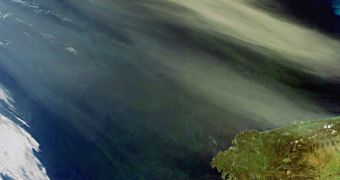One of the most prolific satellites in orbit managed to snap a new image of a portion of the planet containing a piece of North Africa and Western Europe. The view shows huge clouds of sand being channeled over the Atlantic, while the others are in full bloom from phytoplankton.
The latter are microorganisms that represent the base of the aquatic food chain. They bloom under very specific conditions, such as for example when temperature and iron concentrations in the water are at optimum levels.
They play such an important role in the wold's oceans that some have even proposed using them as a means of influencing the world's temperature. Geoengineering is the process of altering Earth's climate at a planetary scale.
Boosting phytoplankton boom is one of the best methods for trapping atmospheric carbon dioxide (CO2) in the oceans. After phytoplankton dies, it sinks to the bottom of the sea, carrying whatever CO2 they consumed with them.
Due to this remarkable ability, experts are keeping track of such blooms all over the world. This particular one takes place off the northwestern tip of the African continent, and can be seen very clearly in this new image collected from orbit.
The view was snapped by the Medium Resolution Imaging Spectrometer (MERIS) instrument aboard the Envisat satellite, which is operated by the European Space Agency (ESA). The photo covers the eastern Atlantic Ocean from Africa to France, England and Ireland.
In the upper-central portion of the image, the yellowish streaks are vast amounts of sand, that are being blown out of the Sahara Desert, above Algeria. The sand is headed westwards, over the Atlantic.
Atmospheric convection currents can carry sand and dust for thousands of miles in all direction, say climate experts. Understanding the role that sand plays in determining Earth's average temperature is one of the main drives in climate science today.
“Sandstorms are very common over the Sahara, and large concentrations of the dust can be found in the tropical Atlantic and the Caribbean,” ESA experts say in a statement accompanying the image.
“The dust contains many nutrients, including nitrogen, phosphorus and iron, which act as a fertilizer and stimulate the production of massive plankton blooms,” they go on to say.
The image was collected by MERIS because the instrument has the ability to sense the colors of the ocean, at a resolution of 300 meters. The photo was collected on April 8, 2011.

 14 DAY TRIAL //
14 DAY TRIAL //